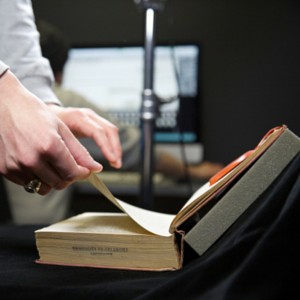NORMAN — Visitors of all ages will have the opportunity to explore connections between the sciences and humanities during a yearlong Galileo’s World exhibition commemorating the University of Oklahoma’s 125th anniversary.
OU Libraries, which is sponsoring the exhibition, maintains one of the most important collections of early manuscripts in the United States. Its History of Science collections include all 12 first editions by Galileo published in his lifetime, four of which contain Galileo’s original handwriting. This exhibition will be the first time all 12 works will be on display at one time.
“I can think of no better way to celebrate the University's 125th anniversary than the showcasing of our internationally recognized collection of first editions and items related to Galileo,” said OU President David L. Boren.
Galileo’s World, a university-wide collaborative exhibition, opens in August. The exhibition will feature rare books, instrument replicas, digital resources and student projects in 20 uniquely themed exhibits in seven locations across the university’s three campuses in Norman, Oklahoma City and Tulsa.
“What started as a ‘thank you’ for a series of acquisitions funded by the OU Athletics Department became a way to open the doors of the university to the public in celebration of OU’s 125th anniversary,” said Rick Luce, dean of OU Libraries. “Paired with the innovations happening across campus, we wanted to take this opportunity to bring the world of Galileo to OU and beyond.”
Exhibits open to the public Aug. 1 at the Sam Noble Museum and the National Weather Center on OU’s Norman campus; the Robert M. Bird Health Sciences Library on the OU Health Sciences campus in Oklahoma City; and the Schusterman Library at OU-Tulsa. Later exhibits also will open at Bizzell Memorial Library, Headington Hall student residence center and the Fred Jones Jr. Museum of Art.
The exhibition begins with a public open house at 3 p.m. Saturday, Sept. 5, coinciding with OU’s first home football game. The open house will be in the newly renovated fifth floor of Bizzell Memorial Library. An opening forum, followed by the opening reception for the National Weather Center exhibits will be held Friday, Sept. 25.
Opening receptions for each location hosting exhibits this fall include:
- the Sam Noble Museum’s opening of Through the Eyes of the Lynx: Galileo, Natural History and the Americas, Aug. 28
- the Robert M. Bird Library’s opening of Galileo and the Health Sciences, Sept. 17
- the Schusterman Library’s opening of the Scientific Revolution, Sept. 26
- and a game day open house for Galileo and Sports at Headington Hall, Oct. 24.
Please see galileo.ou.edu for event times and additional information.
“The Galileo’s World exhibition brings worlds together,” said Kerry Magruder, curator of the History of Science collections. “The story of Galileo reveals the creativity and innovation of human achievement. The interconnectedness of science and culture that characterized Galileo’s world, and which ties Galileo’s world to our own day, remains the common heritage of humanity and is what we explore across the university in this exhibition.”
Additional events include a monthly lecture series beginning November 12 at the Sam Noble Museum, followed by a sky watch hosted by the OU Observatory on the museum lawn; a concert and lecture series hosted by the OU School of Music exploring the birth of the Italian opera and the contributions by Galileo’s father to music theory; a full-day symposium featuring noted scholars discussing topics related to the exhibition; a Stadium Under the Stars family festival; and a world premiere of the play Galileo’s Torch by renowned playwright James Reston Jr.
In addition to the physical exhibits, Galileo’s World will feature a digital component for each location. Every book on display is being digitized and will be openly accessible in its entirety by visiting galileo.ou.edu. Several authentic instrument replicas, including Galileo’s compass, telescope and microscope, provided by the Museo Galileo in Florence, Italy, will be displayed.
Other supplementary content, including exhibit guides for each location and instrument tutorial videos provided by the Museo Galileo, will all be accessible, at no cost, through the website.
Organized through the OU Libraries, the exhibition is available to the public through August 2016. Visitors are encouraged to visit the galileo.ou.edu for more information about the exhibition and to confirm visitor information, programming and event dates.



